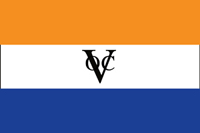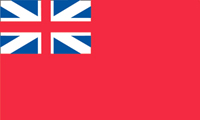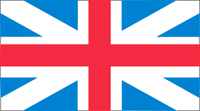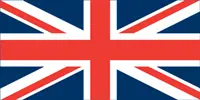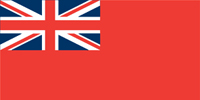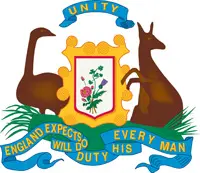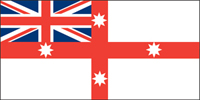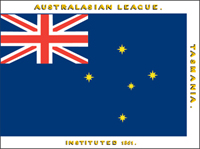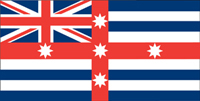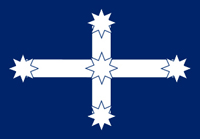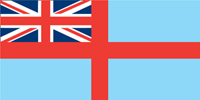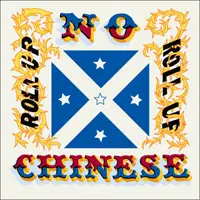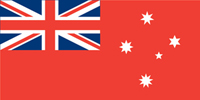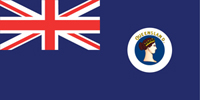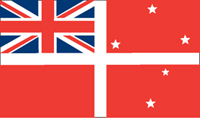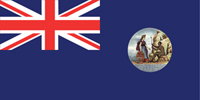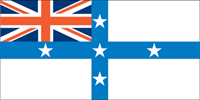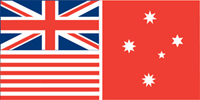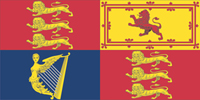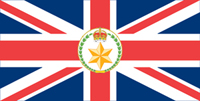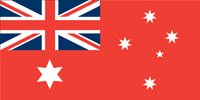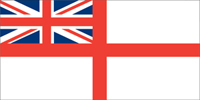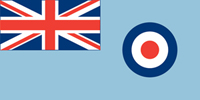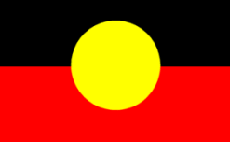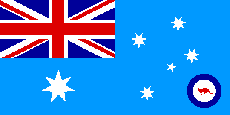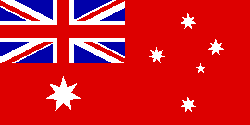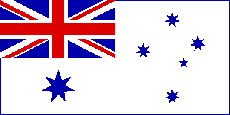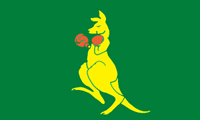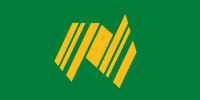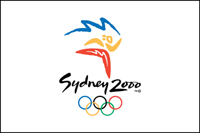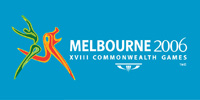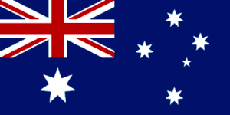
The fag is based on the Blue Ensign. It is a plain blue flag with the British Union Jack in the upper corner of the hoist. This symbolises both Australia’s colonial background and the present-day membership of the British Commonwealth. Underneath is the seven-pointed Commonwealth star. Each point represents either a state or territory. On the right hand side there are five white stars in the shape of the Southern Cross, the constellation most characteristic of the Australian sky at night. At the time of Federation in 1901, there was no Australian flag. Because we were then a colony of Britain, we used British flags. The new Government held an international competition which attracted an enormous number of entries, 32,823! From these the present design was chosen – it had been submitted by five different people, including a 14 year old boy, an 18 year old and a New Zealander. King Edward VII approved a modified version of the design in February 1903.
The original design was similar to the current flag, except the Federation Star contained only 6 points and the Southern Cross was represented by stars ranging from 5 to 9 points to indicate their relative apparent brightness in the night sky. At first this flag was known as the Commonwealth blue ensign but later it became the Australian National flag. The Commonwealth red ensign, or merchant flag, was identical except that it had a red background instead of a blue one. Initially confusion reigned over the two Australian flags. At first the blue ensign was intended for official naval purposes only and the red ensign was to be used by the merchant fleet. However, the public also began using the red ensign on land. (The Flag placed in the time capsule left by Antarctic explorer Sir Hubert Wilkins in 1939 was the Red ensign.)
3rd September each year has been declared Australian National Flag Day (not a public holiday). Any Australian citizen or organisation may display the Australian National Flag. This may be done between 8am and sunset, or at night if properly illuminated.

Flag Adopted: 18th February 1876. All State flags, except the Northern Territory and Australian Capital Territory, use the Australian flag, based on the Blue Ensign, but have the particular badge of that State on the right hand side where the Southern Cross would be.
The flag of New South Wales is the Blue Ensign with the state badge on the right hand side. The badge of NSW consists of the red cross of St George with a golden lion in the centre within a white circle. On each arm of the cross is an 8-pointed star, representing the Southern Cross. The badge was granted in 1876 and is used both on its own and in the State flag.
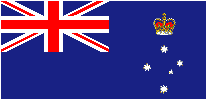
Current flag adopted: circa 1953. Victoria was the first State to have its own flag in 1870. Victoria’s flag is made up of the Blue Ensign with the State badge. The badge consists of the Southern Cross with the Imperial Crown above.
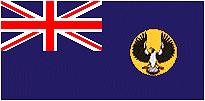
Flag Adopted: 13th January 1904. The flag of South Australia is the Blue Ensign with the State badge. The badge consists of a white-backed piping shrike (magpie) with wings outstretched, within a golden circle. It is believed to have been designed by Robert Craig of the Adelaide School of Arts.
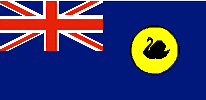
Current flag adopted: circa 1953. The flag of Western Australia is the Blue Ensign with the State badge. The badge consists of the native Black Swan within a yellow circle. The choice of the black swan was suggested in 1870 by Governor Weld for the badge for the colony.
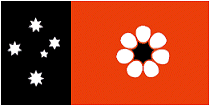
The Northern Territory was founded as a Federal Territory on 1st January 1911. It was granted self-government on 1st July 1978. Until then it used the national flag and Coat of Arms. The flag, designed by Robert Ingpen, a Victorian illustrator, was first flown in 1978. It uses black, white and ochre, basic colours of Aboriginal art. It features the Southern Cross in white on a black panel at the hoist. The centre of the fly has Sturt’s Desert Rose with seven petals on a red ochre background.

Current Flag Adopted: circa 1953. The flag of Queensland is the Blue Ensign with the State badge. The badge features a light blue Maltese cross, with the Imperial Crown in the centre of the cross, within a white circle. This badge, proclaimed in 1876, was designed by the then Queensland Colonial Secretary and Treasurer William Hemmant.

Flag adopted 29th November 1875. The Tasmanian flag is the Blue Ensign with the State badge. The badge consists of a red lion within a white circle. This design reflects historical ties with England. The badge was approved by the British Colonial office in 1875. It has remained largely unchanged since then. It was officially proclaimed in 1975.
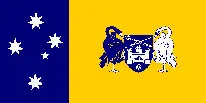
The ACT did not have an official flag prior to the adoption of its new flag by the ACT Legislative Assembly on 25 March 1993. The reason for its long ‘flaglessness’ is simple: it was thought by a number of successive Commonwealth Governments that the ACT should represent all Australia and that the adoption of a specific territorial flag might necessarily detract from its federal representativeness. However, the lack of an identifying flag caused a number of problems. For example, the people of the ACT were singular in not having a unifying official community symbol and this also meant that their sporting teams were not readily identifiable. It was also thought that a flag would give the community as a whole a higher profile. The ACT achieved self-government as recently as 1988. This event undoubtedly enhanced official recognition of the ACT’s ‘personal identity’ and paved the way for the adoption of its own particular territorial flag. Competitions for a new flag were held in 1988 and 1992 and a large number of submissions were received. No consensus was reached within the community regarding any particular design; however, there were some common features among the entries. These elements were incorporated into four base designs, which were informally chosen by members of the Legislative Council, and thereafter presented to the ACT community in February and March 1993. The residents of the ACT were then invited to take part in the selection process of the new flag by informal, non-mandatory vote.
The new flag is unfortunatley not an entirely happy choice. The selection procedure by which the final four designs were chosen has been criticised by many ACT residents and the new flag itself has been described as the ‘best of a bad bunch’. It features the shield of the Coat of Arms of the ACT. The drawing of the crown is the same as that used in the original 1928 grant of arms for the shield and also as part of the crest. The drawing of the ams has not altered from the 1928 grant, and the shape of the crown was not updated after 1953. Therefore, despite the inconsistency created with crowns on other state flag badges, the Tudor style crown (though different again to the Edward VII style of crown we have been talking about recently) was used for the flag in 1993, maintaining consistency with the official drawing of the arms.
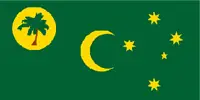
A Federal territory under the control of an Administrator, who is based on Christmas Island. A local flag has been unofficially in use since 2003. The crescent acknowledges that a majority of the small population are Sunni Muslims, descendents of Malays originally brought to the island to provide labour to copra plantations.
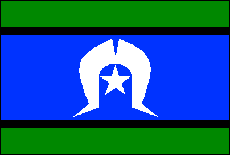
The Torres Strait Islander flag is attributed to the late Bernard Namok of Thursday Island. The flag is emblazoned with a white Dari (headdress) which is a symbol of Torres Strait Islanders. The white five pointed star beneath it symbolises the five major island groups and the navigational importance of stars to these seafaring people. The green stripes represent the land, the black stripes represent the people, and the blue the sea. The flag as a whole symbolises the unity of all Torres Strait Islanders. As with the Aboriginal Flag, the Torres Strait Islander Flag is beginning to be flown more widely and gaining more recognition as indigenous issues gain more prominence in Australia.
The Federal Government initiated steps in 1994 to give the flag legal recognition. After a period of public consultation, the Government decided in July 1995 that the flag should be proclaimed a “Flag of Australia” under section 5 of the Flags Act 1953. The flag was so proclaimed by the Governor General of Australia, William Hayden, on 14 July 1995.

Flag adopted 17th January 1980. Norfolk Island, an Australian external territory since 1913, lies 1400 km east of Australia in the Pacific Ocean and has a permanent population of approximately 2000. Norfolk Island gained a measure of self government when it acquired its own Legislative Assembly in 1979. Soon after, Norfolk Island adopted its own distinctive flag.
Central to the flag is a silhouette of one of Norfolk Island’s most famous symbols – the Norfolk Island Pine tree – which was first used on Norfolk Island’s great seal, granted in 1856. The green stripes on each side symbolise Norfolk Island’s abundant vegetation. The ratio of the widths of the stripes are 7:9:7. The Norfolk Island Flag and Public Seal Act 1979 gives no specifications on the size or exact representation of the tree on the flag, it merely states “the middle panel shall contain a representation in green of a Norfolk Island Pine.”
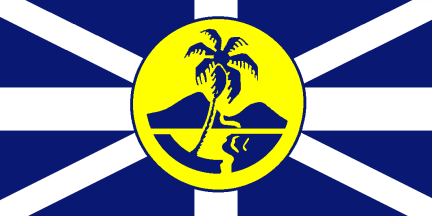
Flag adopted November 1998. An unofficial flag, it was designed by John Vaughan, a Sydney vexillologist and first flown in November 1998. The central badge represents the island’s topography, whilst the field of the flag alludes to the pre-1801 Union Jack. Lord Howe Island is administered by the Lord Howe Island Board on behalf of the NSW Government.
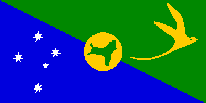
The fag has no legal status, however it has in use since 14th April 1986. Christmas Island is an external Australian Territory in the Indian Ocean, 1700 km northwest of Western Australia. It has an area of 135 square kilometres and a population of approximately 1300. The Christmas Island Assembly held a design competition for an island flag and coat of arms in early 1986. The flag competition attracted 69 entries from residents and non-residents who had lived or worked on the island, and carried a prizemoney of $100.
The winning flag was designed by Tony Couch of Sydney, who worked on Christmas Island for four years as a phosphate mining rigging supervisor, and the design was announced by the Assembly on 14 April 1986. The blue and green triangles represent the sea surrounding the island and the vegetation covering the island respectively. In the blue triangle is the Southern Cross in the same form as it appears on the Australian flag, representing the island’s links with Australia. In the green triangle is a representation of the Golden Bosun Bird, which is unique to Christmas Island and has long been one of the island’s most popular symbols.
In the centre of the flag is a gold disc, which has come to represent the island’s phosphate mining history although it was originally included only for aesthetic reasons to provide a background for the green map of Christmas Island. Although there is no legal impediment to the Christmas Island Assembly formally adopting the above flag as the flag of the Territory, no Act has ever been passed on the island to proclaim the flag nor any Ordinance promulgated to regulate its use. To date, the flag is still unofficial and it is not clear why action has never been taken to formalise it.










